Gob-Side Entry Retained with Soft Roof, Floor, and Seam in Thin Coal Seams: A Case Study
Abstract
1. Introduction
2. Mining Geological Conditions of Tested Roadway
- (1)
- The roof was supported by Φ18 mm × 2000 mm bolts, and five rows were set up with the spacing of 900 mm × 1000 mm. The bolts were arranged by a steel ladder beam welded with round steel, 14 mm in diameter and 3800 mm long. The roof was also supported by Φ17.8 mm × 6300 mm anchor cables, and a row was set up with the spacing of 3000 mm along the roadway. The roof was wrapped by a net, which was 4000 mm wide and 1100 mm long.
- (2)
- The coal rib was supported by Φ18 mm × 2000 mm bolts, and three rows were set up with the spacing of 900 mm × 1000 mm. The bolts were arranged by the steel ladder beam welded with round steel, 14 mm in diameter and 2100 mm long. The coal rib was wrapped by a net, which was 2300 mm wide and 1100 mm long.
3. GER with Soft Roof, Floor, and Seam in TCMs
3.1. Structural Characteristics of Overburden Strata for GER with Soft Roof, Floor and Seam in TCMs
- (1)
- Soft roof fracture state (immediate roof): As the working face advances, the roadside backfill body (RBB) is constructed. The immediate roof behind the active working face fractures along the RBB edge due to the early RBB support resistance and the roof weight. During this stage, Block B forms and rotates (see Figure 6a).
- (2)
- Hard roof fracture stage (main roof): Block B fractures and forms Blocks B1 and B2 as the tensile stress of Block B is greater than its ultimate tensile strength. Block B1 rotates towards the gob due to the abutment pressure behind the active working face (see Figure 6b).
3.2. Difficulties in Surrounding Rock Control for GER with Soft Roof, Floor, and Seam in TCMs
- (1)
- Solid coal rib stability control is difficult. Due to the soft surrounding rock (soft roof, floor, and seam), the roof structure would be far away from the retained entry, and the retained entry would be subjected to dynamic pressure action for a long time. Under this condition, the solid coal rib would be severely deformed.
- (2)
- The mechanical properties of the RBB should be appropriate. It is easy for the RBB to bump, crack, and even slip down due to the horizontal thrust of the rotated main roof. Therefore, the RBB must be stable and have some yieldability to adapt the roof sink and rotation. Moreover, the resistance of the RBB is able to cut the roof along the gob.
- (3)
- Soft roof control is difficult to keep stable. The immediate roof is mudstone with little strength and stiffness. As the working face advances, it is easy for the soft roof above the RBB to fracture and cave. Therefore, reasonable control technology should be adopted to keep the roof stable, realize the support resistance transfer between the RBB and the overlying strata, and effectively cut off the immediate roof along the gob.
3.3. Surrounding Rock Stability Control Technology for GER with Soft Roof, Floor, and Seam in TCMs
3.3.1. Support Technology of Prestressed RBB with High Resistance and Quick-Setting
3.3.2. Road-in Support Technology of “Roof Control and Coal Rib Reinforcement” for GER with Soft Roof, Floor, and Seam in TCMs
3.3.3. Roof Support Technology above RBBs for GER with Soft Roof, Floor, and Seam in TCMs
- (1)
- Anchoring technology for the roof above the RBB. Anchor cables and bolts can be set up before the RBB is constructed. The roof above the RBB would change from unloading state in the vertical direction into triaxial compressive stress state, avoiding strong tensile damage and restraining the further development of joints and cracks in the roof rock mass.
- (2)
- High-strength polyester fiber mesh would be placed on the roof above the RBB ahead of four to five hydraulic supports at the end of the working face after cutting the coal. The integrity of the roof above the RBB would be improved.
- (3)
- A reasonable primary filling length is essential. According to the space and time coordination relationship between the support techniques, a reasonable primary filling length can be obtained to diminish the hanging roof area above the RBB, avoid further rotation and subsidence of the main roof, construct the RBB in time, and ensure that the RBB supports the roof in time.
4. Key Parameter Design for GER with Soft Roof, Floor, and Seam in TCMs
4.1. Support Resistance of RBBs for GER with Soft Roof, Floor and Seam in TCMs
4.2. RBB Width and Strength for GER with Soft Roof, Floor, and Seam in TCMs
5. Engineering Practice
5.1. Field Test
5.2. Field Monitoring
- (1)
- The No. 1103 haulage roadway suffers mining stress 40 m ahead of the active 1103 working face. However, the obvious deformation appears 18 to 20 m ahead of the active 1103 working face. The total solid coal rib to excavation rib convergence along the middle of the rib (AC direction) reaches 99.2 mm, while the total floor to roof convergence along the middle of the roadway (BD direction) reaches 167.7 mm ahead of the active 1103 working face.
- (2)
- Surrounding rock characteristics of GER behind the active 1103 working face can be divided into three stages. The first stage is 0 to 10 m behind the active 1103 working face, where the surrounding rock deformation is relatively small. The second stage is 10 to 60 m behind the active 1103 working face, where the surrounding rock deformation is intensively due to the periodic weighting and main roof fracture. The third stage is more than 60 m behind the active 1103 working face, where the surrounding rock deformation is almost stable. The total solid coal rib to excavation rib convergence along the middle of the rib (AC direction) reaches 263.5 mm, while the total floor to roof convergence along the middle of the retained roadway (BD direction) reaches 495.4 mm behind the active 1103 working face.
- (3)
- The solid coal rib to excavation rib convergence is consistently more than the floor to roof convergence, especially behind the active 1103 working face. The final deformation difference of the solid coal rib to excavation rib convergence and the floor to roof convergence is 316.9 mm.
6. Discussion
6.1. Influence on Surrounding Rock Stability of RBB Width and Strength for GER with Soft Roof, Floor, and Seam in TCMs
6.1.1. Numerical Model and Verification
6.1.2. Influence on Surrounding Rock Stability of RBB width for GER with Soft Roof, Floor, and Seam in TCMs
6.1.3. Influence on Surrounding Rock Stability of Water Cement Ratio (RBB strength) for GER with Soft Roof, Floor, and Seam in TCMs
6.2. Influence Factors of Roof Stability for GER with Soft Roof, Floor, and Seam in TCMs
6.2.1. Influence on Roof Stability for GER with Respect to Immediate Roof Height
- (1)
- The roof vertical stress decreases and then increases as the distance to the outer edge of the RBB increases. That is, the vertical stress distribution in the roof is V-shaped. The minimum roof vertical stress is basically located at the middle of the retained roadway, and the minimum roof vertical stress increases with the increase of the immediate roof height. The roof vertical stress close to the gob is larger than that close to the retained roadway.
- (2)
- The roof vertical stress above the RBB close to the gob is higher than the in-situ stress, and the vertical stress above the RBB close to the retained roadway is lower than the in-situ stress. Tensile stress appears in the middle of the retained roadway roof, and the distribution width of roof tensile stress increases with the increase of the immediate roof height.
- (3)
- The roof vertical stress increases as the distance to the edge of the solid coal rib increases.
6.2.2. Influence on Roof Stability for GER with Respect to Main Roof Height
- (1)
- As the distance to the outer edge of the RBB increases, the roof vertical stress above the RBB increases and then decreases. That is, the vertical stress distribution in the monitoring roof above the RBB is Ʌ-shaped. The roof vertical stress above the RBB close to the gob decreases and then increases as the height of the main roof increases. The roof vertical stress above the RBB close to the retained roadway increases and then decreases as the height of the main roof increases.
- (2)
- As the distance to the outer edge of the RBB increases, the vertical stress distribution in the monitoring roof is N-shaped. The minimum roof vertical stress is basically located at the middle of the retained roadway, and the minimum roof vertical stress increases as the height of the main roof increases. Tensile stress appears in the middle of the retained roadway roof, and the distribution width of roof tensile stress increases with the increase of the main roof height.
- (3)
- As the distance to the edge of the solid coal rib increases, the roof vertical stress above the solid coal rib increases. With the increase of the main roof height, the roof vertical stress above the solid coal rib decreases.
6.2.3. Influence on Roof Stability for GER with Respect to GER Width
- (1)
- When the GER width is no more than 5.0 m, the roof vertical stress above the RBB decreases as the distance to the outer edge of the RBB increases. When the GER width is more than 5.0 m, the roof vertical stress above the RBB increases as the distance to the outer edge of the RBB increases
- (2)
- As the distance to the outer edge of the RBB increases, the roof vertical stress above the retained roadway increases and then decreases. That is, the vertical stress distribution in the monitoring roof above the retained roadway is V-shaped. The minimum roof vertical stress is basically located at the middle of the retained roadway. Tensile stress appears in the middle of the retained roadway roof, and the distribution width of roof tensile stress increases with the increase of the GER width.
- (3)
- With the increase of the GER width, the roof vertical stress above the solid coal rib decreases.
6.2.4. Influence on Roof Stability for GER with Respect to RBB Width
- (1)
- When the RBB width is more than 0.5 m, the roof vertical stress above the RBB decreases as the distance to the outer edge of the RBB increases. When the GER width is more than 0.5 m, the roof vertical stress above the RBB is “Ʌ” shaped as the distance to the outer edge of the RBB increases. The roof vertical stress above the RBB decreases as the RBB width increases.
- (2)
- Tensile stress appears in the middle of the retained roadway roof, and the distribution width of roof tensile stress decreases with the increase of the RBB width.
- (3)
- With the increase of the RBB width, the roof vertical stress above the solid coal rib increases.
7. Conclusions
Author Contributions
Funding
Conflicts of Interest
References
- Yang, H.Y.; Cao, S.G.; Wang, S.Q.; Fan, Y.C.; Wang, S.; Chen, X.Z. Adaptation assessment of gob-side entry retaining based on geological factors. Eng. Geol. 2016, 209, 143–151. [Google Scholar] [CrossRef]
- Tan, Y.L.; Yu, F.H.; Ning, J.G.; Zhao, T.B. Design and construction of entry retaining wall along a gob side under hard roof stratum. Int. J. Rock Mech. Min. Sci. 2015, 77, 115–121. [Google Scholar] [CrossRef]
- Zhang, N.; Yuan, L.; Han, C.L.; Xue, J.H.; Kan, J.G. Stability and deformation of surrounding rock in pillarless gob-side entry retaining. Saf. Sci. 2012, 50, 593–599. [Google Scholar] [CrossRef]
- Wang, H.S.; Zhang, D.S.; Liu, L.; Guo, W.B.; Fan, G.W.; Song, K.; Wang, X.F. Stabilization of Gob-Side Entry with an Artificial Side for Sustaining mining work. Sustainability 2016, 8, 627. [Google Scholar] [CrossRef]
- Zhang, Z.Y.; Shimada, H.; Sasaoka, T.; Hamanaka, A. Stability control of retained goaf-side gateroad under different roof conditions in deep underground y type longwall mining. Sustainability 2017, 9, 1671. [Google Scholar] [CrossRef]
- Luan, H.J.; Jiang, Y.J.; Lin, H.L.; Li, G.F. Development of a new gob-side entry-retaining approach and its application. Sustainability 2018, 10, 470. [Google Scholar] [CrossRef]
- Kang, H.P.; Niu, D.L.; Zhang, Z.; Lin, J.; Li, Z.H.; Fan, M.J. Deformation characteristics of surrounding rock and supporting technology of gob-side entry retaining in deep coal mine. Chin. J. Rock Mech. Eng. 2010, 29, 1977–1987. [Google Scholar]
- Zhang, B.; Ma, Z.Y.; Wang, X.; Zhang, J.S.; Peng, W.Q. Reliability analysis of anti-seismic stability of 3D pressurized tunnel faces by response surfaces method. Geomech. Eng. 2020, 20, 43–54. [Google Scholar]
- Yin, Y.C.; Zhao, T.B.; Zhang, Y.B.; Tan, Y.L.; Qiu, Y.; Taheri, A.; Jing, Y. An innovative method for placement of gangue backfilling material in steep underground coal mines. Minerals 2019, 9, 107. [Google Scholar] [CrossRef]
- Ma, L.Q.; Zhang, D.S.; Chen, T.; Fan, G.W. Study on packing body supporting resistance of enter-in packing for in-situ gob-side entry retaining in fully mechanized top-coal caving mining face. Chin. J. Rock Mech. Eng. 2007, 26, 544–550. [Google Scholar]
- Ning, J.G.; Liu, X.S.; Tan, J.; Gu, Q.H.; Tan, Y.L.; Wang, J. Control mechanisms and design for a “coal-backfill-gangue” support system for coal mine gob-side entry retaining. Int. J. Oil Gas Coal Tech. 2018, 18, 444–466. [Google Scholar] [CrossRef]
- Liu, X.S.; Ning, J.G.; Tan, Y.L.; Gu, Q.H. Coordinated supporting method of gob-side entry retaining in coal mines and a case study with hard roof. Geomech. Eng. 2018, 15, 1173–1182. [Google Scholar]
- Wang, Q.; He, M.C.; Yang, J.; Gao, H.K.; Jiang, B.; Yu, H.C. Study of a no-pillar mining technique with automatically formed gob-side entry retaining for longwall mining in coal mines. Int. J. Rock Mech. Min. Sci. 2018, 110, 1–8. [Google Scholar] [CrossRef]
- Zhang, G.C.; Wen, Z.J.; Liang, S.J.; Tan, Y.L.; Tian, L.; Zhao, Y.Q.; Zhao, D.S. Ground response of a gob-side entry in a longwall panel extracting 17 m-thick coal seam: A case study. Rock Mech. Rock Eng. 2019. [Google Scholar] [CrossRef]
- Zhang, G.C.; Tan, Y.L.; Liang, S.J.; Jia, H.G. Numerical estimation of suitable gob-side filling wall width in a highly gassy longwall mining panel. Int. J. Geomech. 2018, 18, 04018091. [Google Scholar] [CrossRef]
- Li, X.H.; Ju, M.H.; Yao, Q.L.; Zhou, J.; Chong, Z.H. Numerical investigation of the effect of the location of critical rock block fracture on crack evolution in a gob-side filling wall. Rock Mech. Rock Eng. 2016, 49, 1041–1058. [Google Scholar] [CrossRef]
- Huang, W.P.; Yuan, Q.; Tan, Y.L.; Wang, J.; Liu, G.L.; Qu, G.L. An innovative support technology employing a concrete-filled steel tubular structure for a 1000 m-deep roadway in a high in situ stress field. Tunn. Undergr. Space Technol. 2018, 73, 26–36. [Google Scholar] [CrossRef]
- Chen, Y.; Bai, J.B.; Wang, X.Y.; Ma, S.Q.; Xu, Y.; Bi, T.F.; Yang, H. Support technology research and application inside roadway of gob-side entry retaining. J. China Coal Soc. 2012, 37, 903–910. [Google Scholar]
- Kong, P.; Jiang, L.S.; Shu, J.M.; Sainoki, A.; Wang, Q.B. Effect of fracture heterogeneity on rock mass stability in a highly heterogeneous underground roadway. Rock Mech. Rock Eng. 2019. [Google Scholar] [CrossRef]
- Wu, B.W.; Wang, X.Y.; Bai, J.B.; Wu, W.D.; Zhu, X.X.; Li, G.D. Study on crack evolution mechanism of roadside backfill body in gob-side entry retaining based on UDEC trigon model. Rock Mech. Rock Eng. 2019, 52, 3385–3399. [Google Scholar] [CrossRef]
- Wu, Q.H.; Chen, L.; Shen, B.T.; Dlamini, B.; Li, S.Q.; Zhu, Y.J. Experimental investigation on rockbolt performance under the tension load. Rock Mech. Rock Eng. 2019, 52, 4605–4618. [Google Scholar] [CrossRef]
- Duan, H.Q.; Sun, M.; Li, Q. A new gob-side entry retaining approach with reinforced filling gangue wall in thin coal seam. Geotech. Geol. Eng. 2019. [Google Scholar] [CrossRef]
- Wu, Q.H.; Li, X.B.; Weng, L.; Li, Q.F.; Zhu, Y.J.; Luo, R. Experimental investigation of the dynamic response of prestressed rockbolt by using an SHPB-based rockbolt test system. Tunn. Undergr. Space Technol. 2019, 93, 103088. [Google Scholar] [CrossRef]
- Han, C.L.; Zhang, N.; Xue, J.H.; Kan, J.G.; Zhao, Y.M. Multiple and long-term disturbance of gob-side entry retaining by grouped roof collapse and an innovative adaptive technology. Rock Mech. Rock Eng. 2019, 52, 2761–2773. [Google Scholar] [CrossRef]
- Feng, X.W.; Zhang, N. Position-optimization on retained entry and backfilling wall in gob-side entry retaining techniques. Int. J. Coal Sci Technol. 2015, 3, 186–195. [Google Scholar] [CrossRef]
- Zhang, Z.Z.; Wang, W.J.; Li, S.Q.; Yu, X.Y. Analysis on rockbolt support interaction with roof dilatancy above roadside backfill area in gob-side entry retaining. Geotech. Geol. Eng. 2018, 36, 2577–2591. [Google Scholar] [CrossRef]
- Ma, Q.; Tan, Y.L.; Zhao, Z.H.; Xu, Q.; Wang, J.; Ding, K. Roadside support schemes numerical simulation and field monitoring of gob-side entry retaining in soft floor and hard roof. Arabian J. Geosci. 2018, 11, 563. [Google Scholar] [CrossRef]
- Zhang, Z.Z.; Yu, X.Y.; Deng, M. Damage evolution of sandy mudstone mechanical properties under mining unloading conditions in gob-side entry retaining. Geotech. Geol. Eng. 2019, 37, 3535–3545. [Google Scholar] [CrossRef]
- Yan, S.; Liu, T.X.; Bai, J.B.; Wu, W.D. Key parameters of gob-side entry retaining in a gassy and thin coal seam with hard roof. Processes 2018, 6, 51. [Google Scholar] [CrossRef]
- Zhang, Z.Z.; Wang, W.J.; Li, S.Q.; Yu, X.Y. An innovative approach for gob-side entry retaining with thick and hard roof: A case study. Tech. Gaz. 2018, 25, 1028–1036. [Google Scholar]
- Zhang, Z.Z.; Bai, J.B.; Wang, W.J.; Chen, Y.; Yu, X.Y.; Wu, H. Mechanical analysis of roof separation within and outside anchorage zone above backfill area of gob-side entry retaining and its engineering application. J. Min. Saf. Eng. 2018, 25, 1028–1036. [Google Scholar]
- Zhang, Z.Z.; Bai, J.B.; Chen, Y.; Li, M. Investigation and application analysis of unbalanced bearing characteristics of gob-side entry retaining. Rock Soil Mech. 2015, 36, 2665–2673. [Google Scholar]
- Zhang, Z.Z.; Bai, J.B.; Chen, Y.; Yan, S. An innovative approach for gob-side entry retaining in highly gassy fully-mechanized longwall top-coal caving. Int. J. Rock Mech. Min. Sci. 2015, 80, 1–11. [Google Scholar] [CrossRef]
- Li, P. Research on gob-side entry retaining with waste filling in close thin seam with hard roof and floor. China Coal. 2017, 43, 67–71. [Google Scholar]
- Zhang, J.X.; Jiang, H.Q.; Miao, X.X.; Zhou, N.; Zan, D.F. The rational width of the support body of gob-side entry in fully mechanized backfill mining. J. Min. Safe. Eng. 2013, 30, 159–164. [Google Scholar]
- Quan, K.; Liu, Z.C.; Xu, X.Y.; Liu, Y. Study on mechanical mechanism of roof subsidence in gob side entry retaining under consolidated backfill mining. Coal Sci. Tech. 2018, 46, 33–38. [Google Scholar]
- Heng, D.; Zhang, J.Y. Research on short-distance pumped concrete used in gob-side entry retaining under thin coal seam. Coal Eng. 2018, 50, 10–13. [Google Scholar]
- Tang, J.X.; Deng, Y.H.; Tu, X.D.; Hu, H. Analysis of roof separation in gob-side entry retaining combined support with bolting wire mesh. J. China Coal Soc. 2010, 35, 1827–1831. [Google Scholar]
- Chen, W.X.; Tian, Y.S.; Wang, Z.F.; Wang, F.Q.; Cui, S.L. Application of flexible template gob-side entry fast retaining technology in Shendong mining area. Coal Eng. 2016, 48, 1–4. [Google Scholar]
- Fan, D.Y.; Liu, X.S.; Tan, Y.L.; Yan, L.; Song, S.L.; Ning, J.G. An innovative approach for gob-side entry retaining in deep coal mines: A case study. Energy Sci. Eng. 2019, 7, 2321–2335. [Google Scholar] [CrossRef]
- Su, H.; Bai, J.B.; Yan, S.; Chen, Y.; Zhang, Z.Z. Study on gob-side entry retaining in fully-mechanized longwall with top-coal caving and its application. Int. J. Min. Sci. Tech. 2015, 25, 503–510. [Google Scholar] [CrossRef]
- Cao, S.G.; Zhou, D.J.; Bai, Y.J.; Wen, D.C.; Yang, Y.G.; He, P.J. Study on upward mining of sublevels for gob-side entry retaining in three-soft thin coal seam group. J. Min. Safe. Eng. 2012, 29, 322–327. [Google Scholar]
- Zhang, Z.Z.; Yu, X.Y.; Wu, H.; Deng, M. Stability control for gob-side entry retaining with supercritical retained entry width in thick coal seam longwall mining. Energies 2019, 12, 1375. [Google Scholar] [CrossRef]
- Zhang, Z.Z.; Deng, M.; Bai, J.B.; Yu, X.Y.; Wu, Q.H.; Jiang, L.S. Strain energy evolution and conversion under triaxial unloading confining pressure tests due to gob-side entry retained. Int. J. Rock Mech. Min. Sci. 2020, 126, 104184. [Google Scholar] [CrossRef]
- Chen, Y.; Bai, J.B.; Zhu, T.L.; Yan, S.; Zhao, S.H.; Li, X.C. Mechanisms of roadside support in gob-side entry retaining and its application. Rock Soil Mech. 2012, 33, 1427–1432. [Google Scholar]
- Wu, W.D.; Bai, J.B.; Wang, X.Y.; Yan, S.; Wu, S.X. Numerical Study of Failure Mechanisms and Control Techniques for a Gob-side Yield Pillar in the Sijiazhuang Coal Mine, China. Rock Mech. Rock Eng. 2019, 52, 1231–1245. [Google Scholar] [CrossRef]
- Wu, W.D.; Bai, J.B.; Wang, X.Y.; Zhu, Z.J. Field investigation of fractures evolution in overlying strata caused by extraction of the jurassic and carboniferous coal seams and its application: Case study. Int. J. Coal Geol. 2019, 208, 12–23. [Google Scholar] [CrossRef]


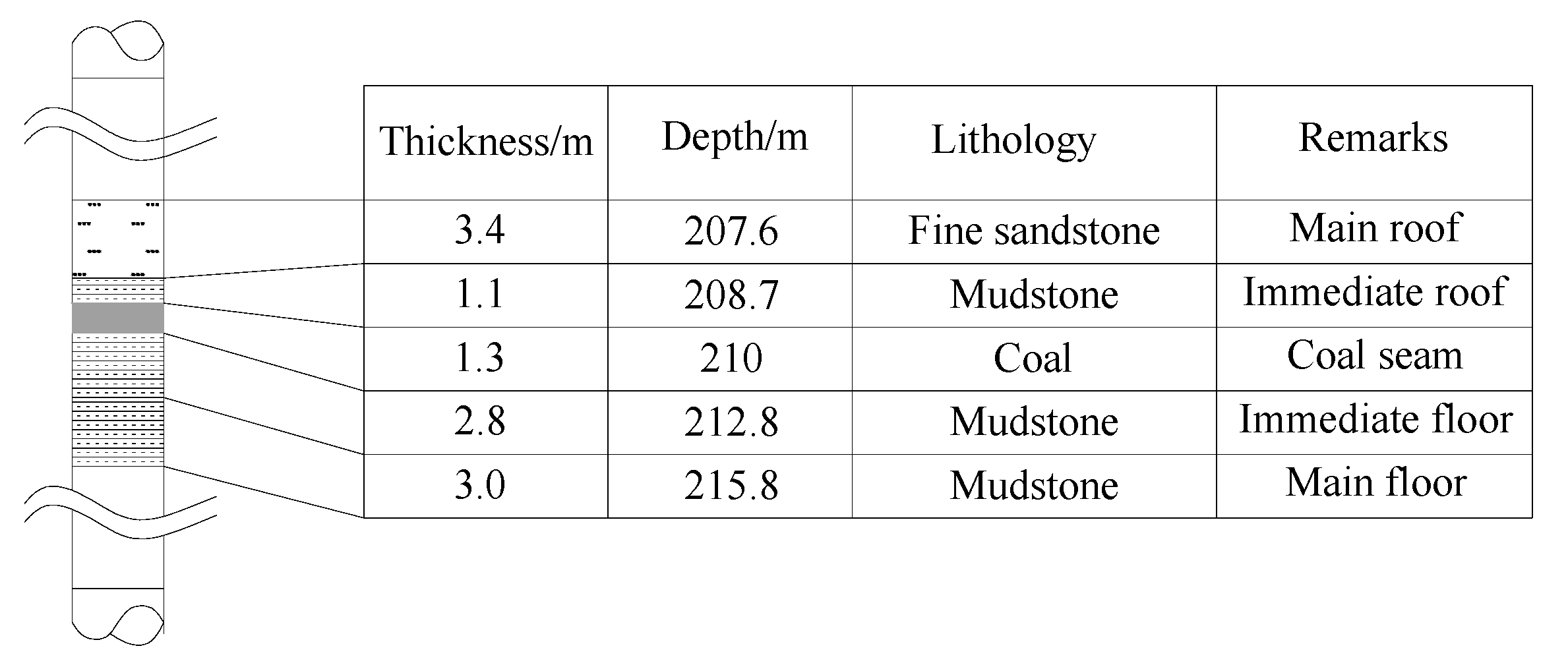

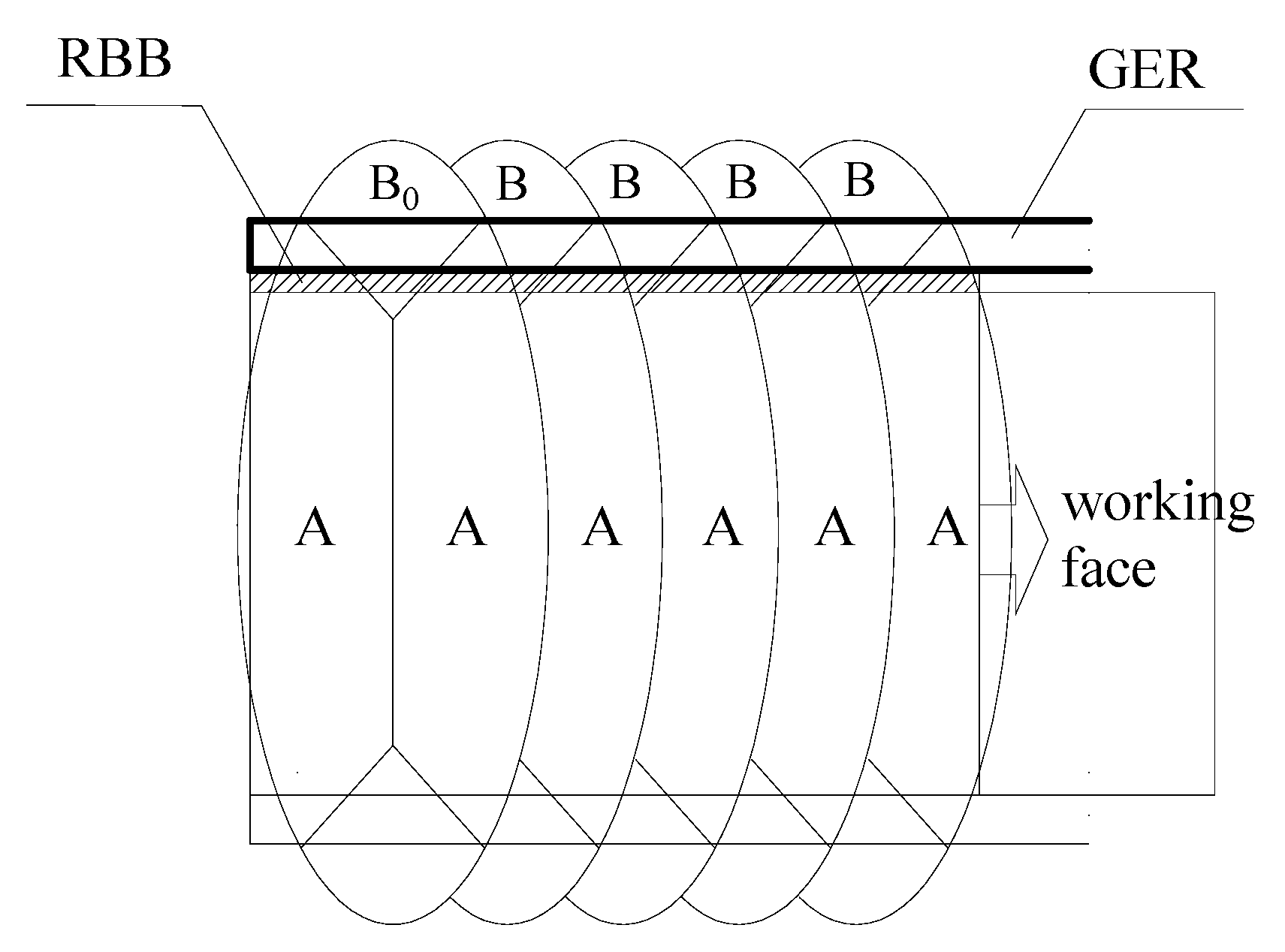



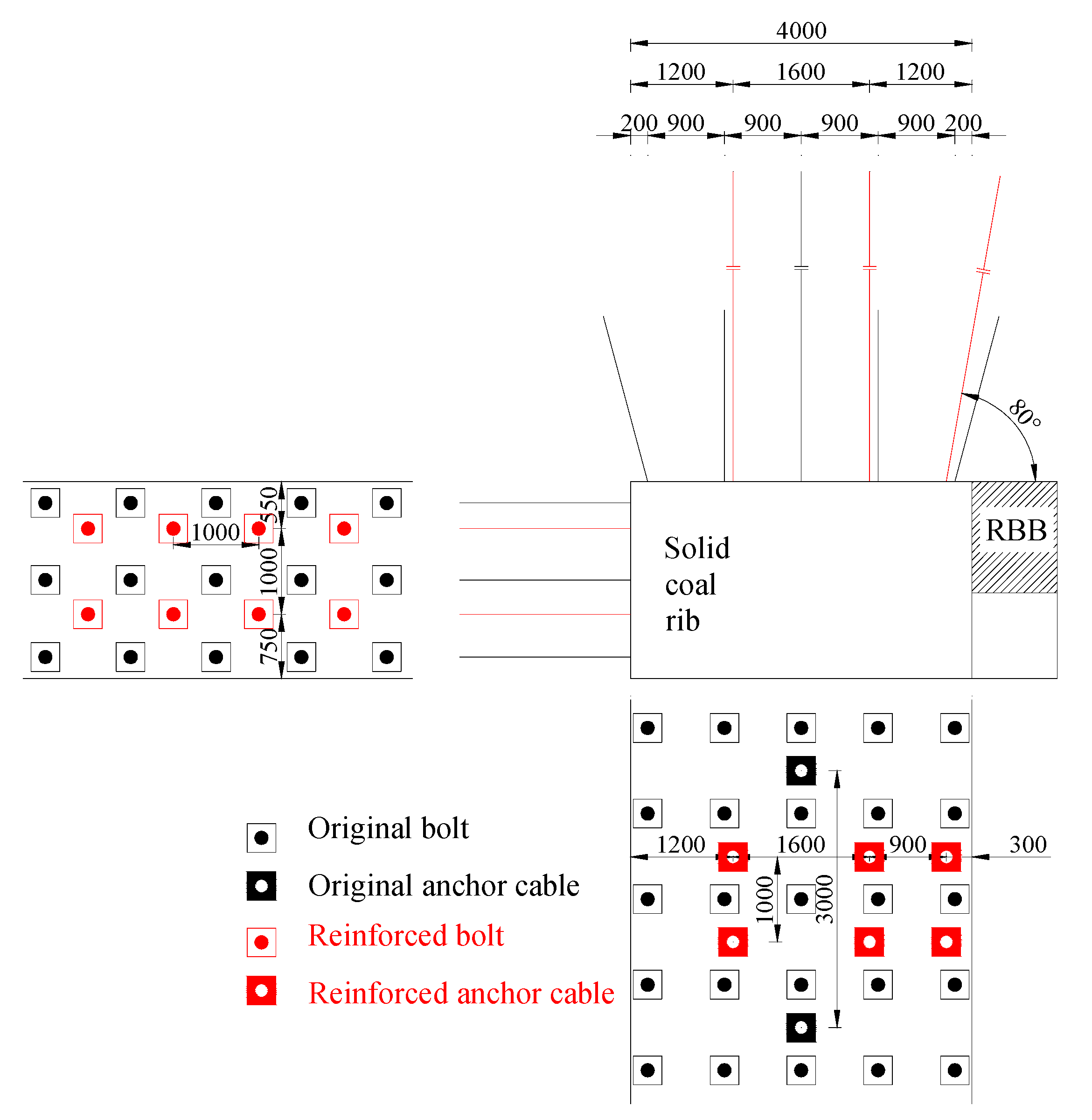
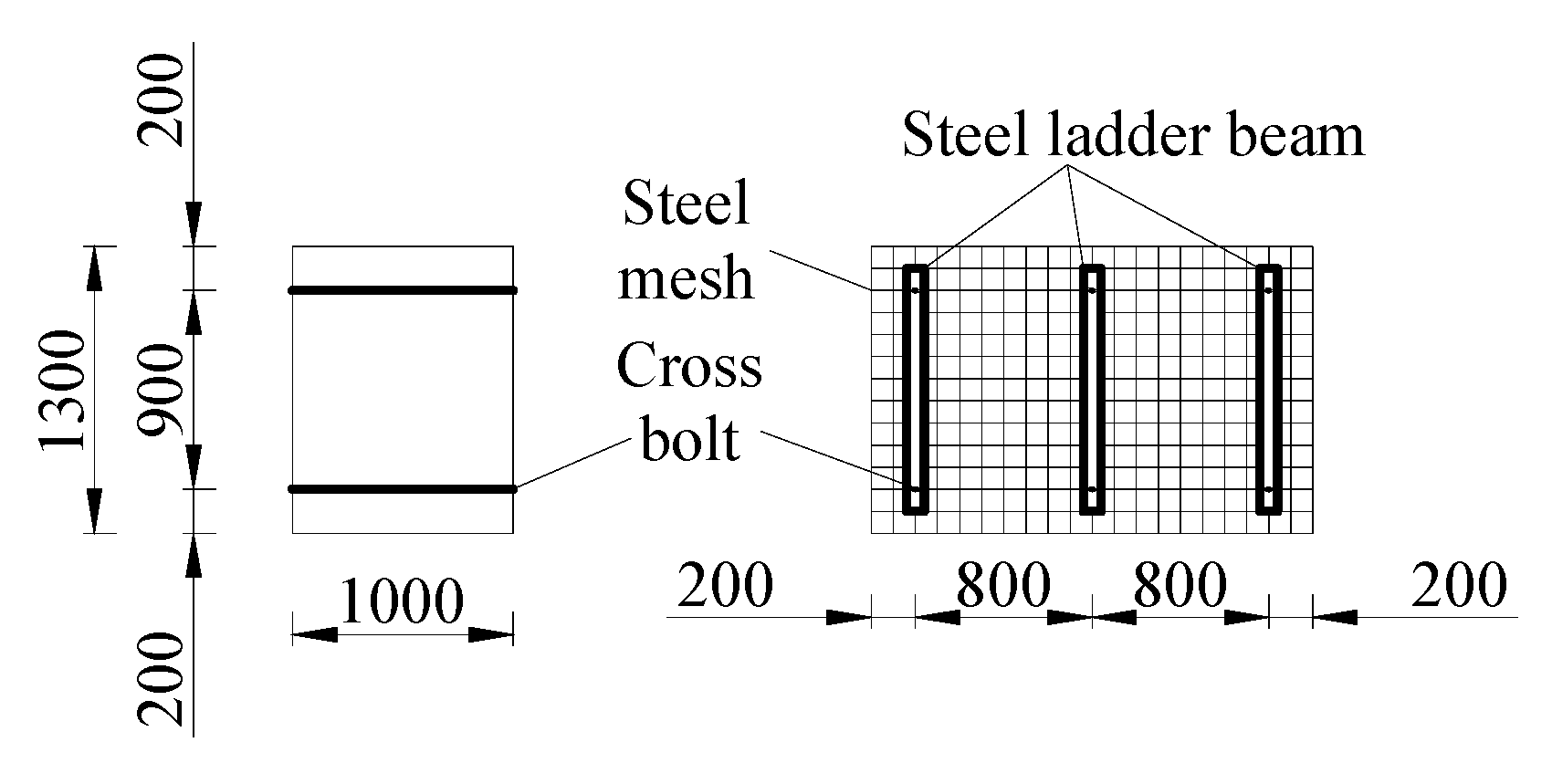


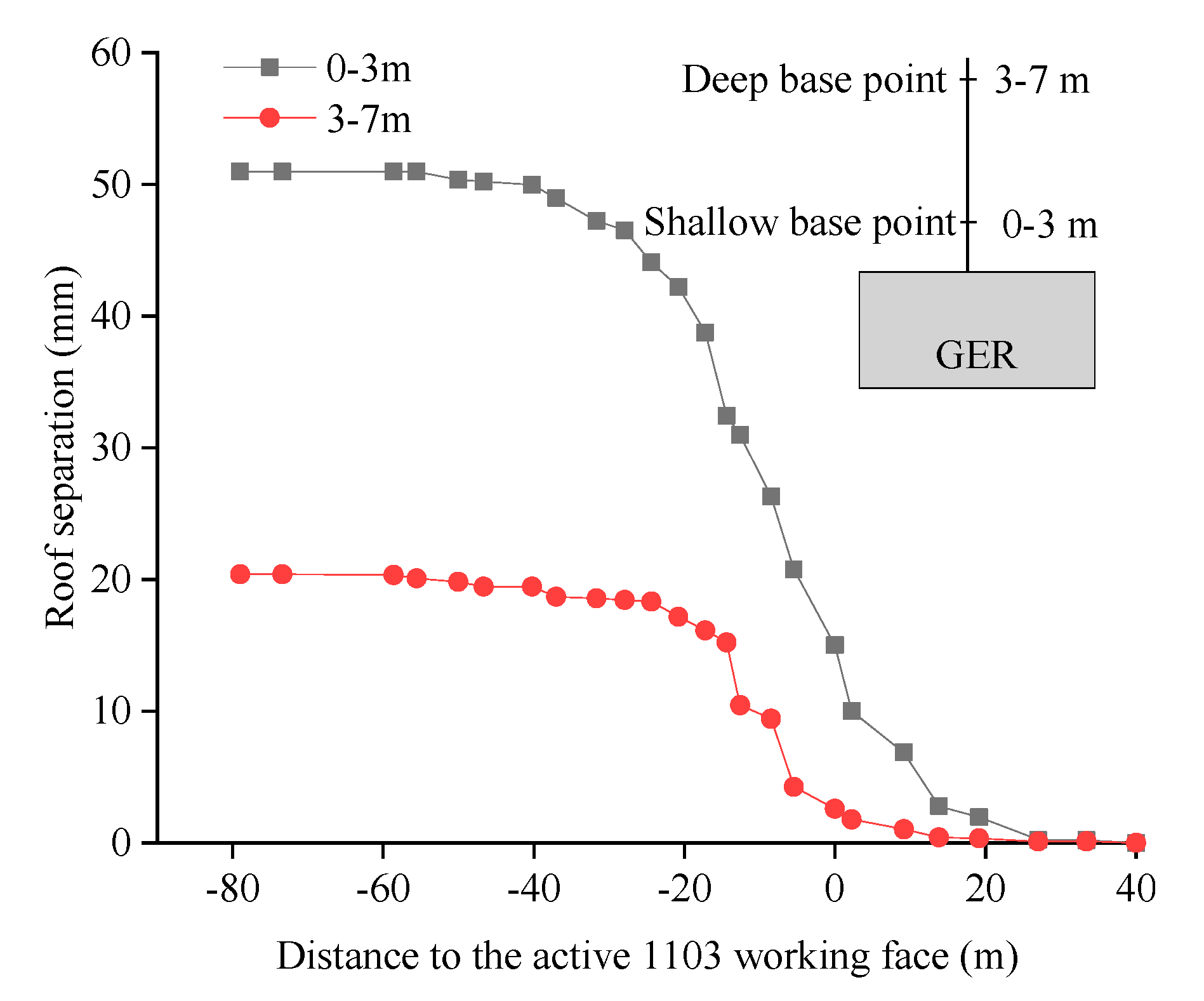


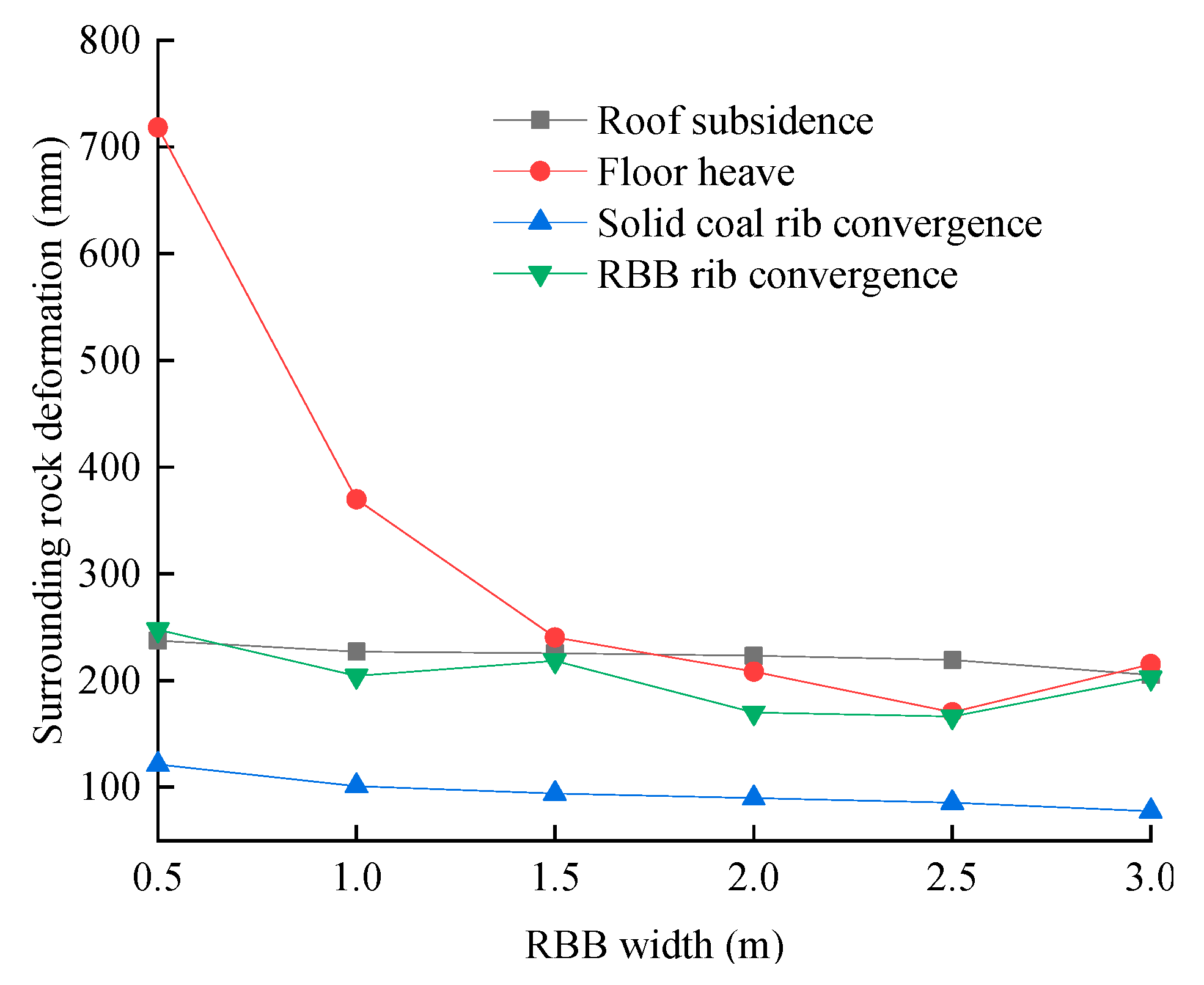




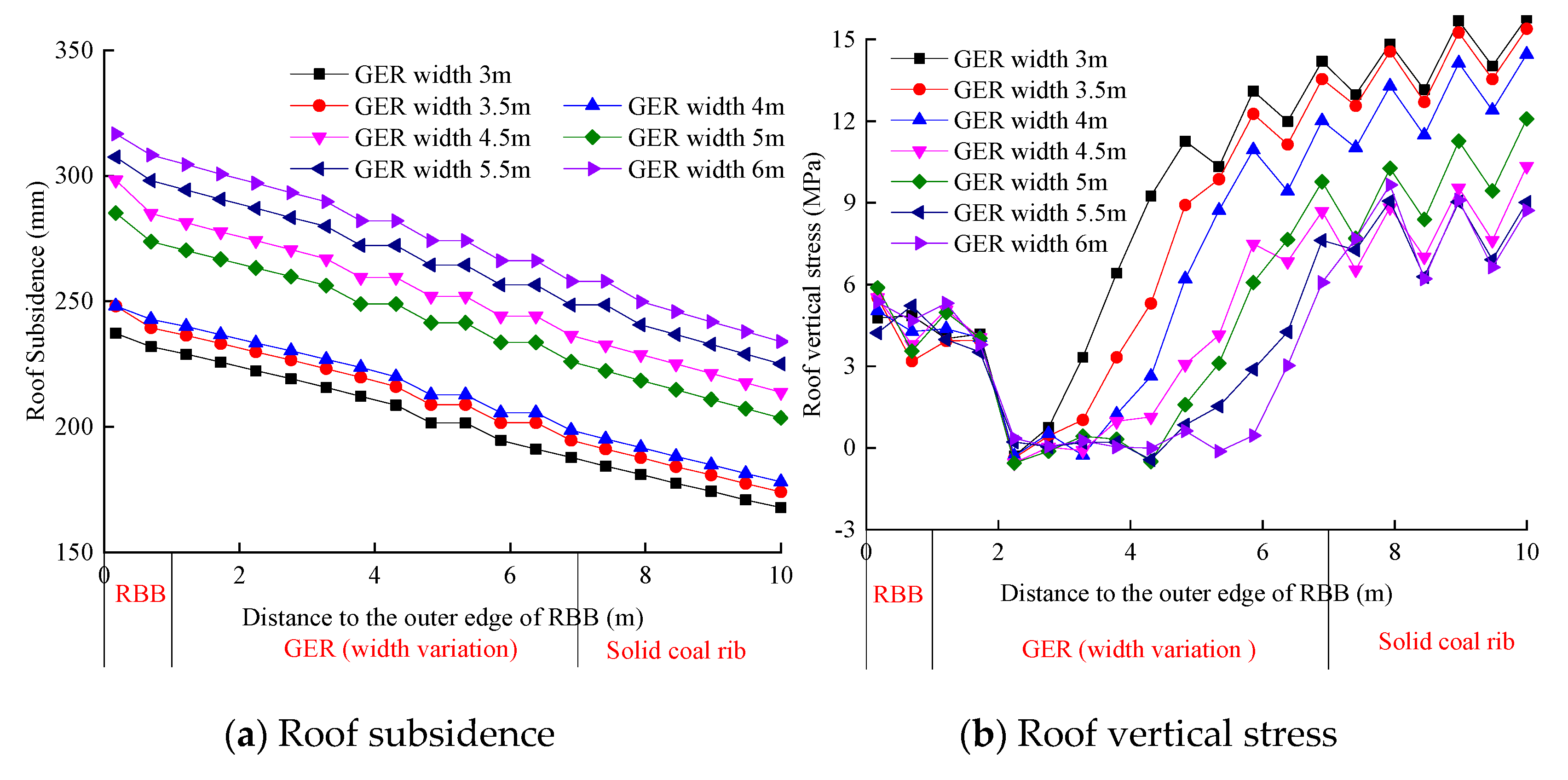
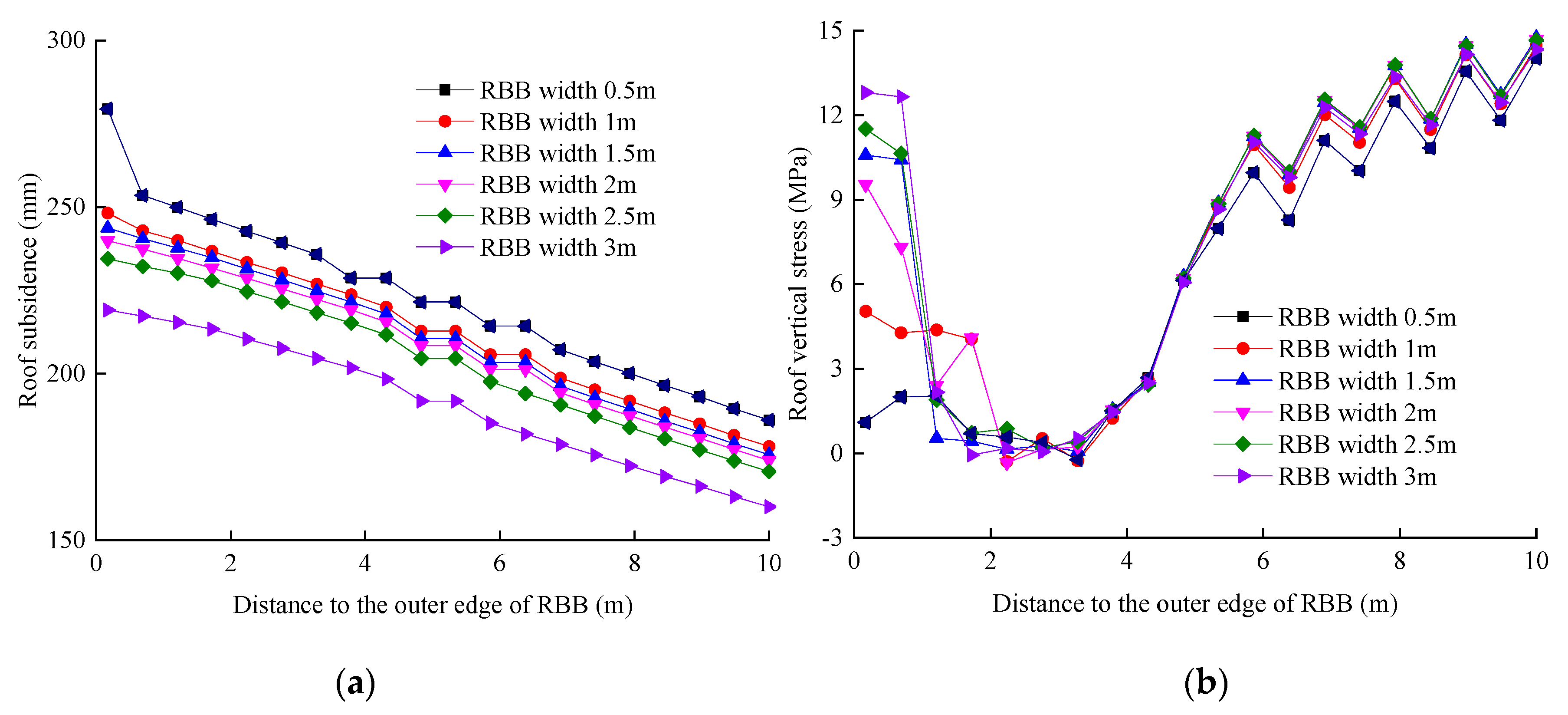
| Coal Mine | Coal Seam Height (m) | Buried Depth (m) | Coal Seam Dip Angle (°) | Immediate Roof Height (m) | Main Roof Height (m) | Water Cement Ratio | RBB Width (m) | GER Width (m) |
|---|---|---|---|---|---|---|---|---|
| Nantun [29] | 0.9 | 420 | 4 | 5.0 (Limestone) | 6.4 (Mudstone) | 1.5:1 | 1.2 | 3.8 |
| Xinchao [30] | 3.2 | 180 | 10 | 3.0 (Limestone) | 2.9 (Fine sandstone) | 1.5:1 | 3.0 | 4.2 |
| Liujiazhuang [32] | 4.0 | 240 | 4 | 3.5 (Sandy mudstone) | 6.0 (gritstone) | 1.5:1 | 3.0 | 4.5 |
| Yuwu [33] | 6.3 | 575 | 1.5 | 5.2 (Siltstone) | 6.4 (Packsand) | 1.5:1 | 1.5 | 4.8 |
| Xingwu [31] | 3.0 | 270 | 5 | 12.1 (Sandy mudstone) | 6.5 (Medium sandstone) | 1.5:1 | 2.5 | 4.5 |
| Xinyuan [43,44] | 2.8 | 500 | 4 | 7.1 (Sandy mudstone) | 5.4 (Medium sandstone) | 1.5:1 | 2.5 | 5.2 |
| Jiulishan [45] | 3.0 | 350 | 11 | 6.3 (Siltstone) | 21.9 (Packsand) | 1.5:1 | 3.0 | 4.5 |
| Qinxin [18] | 1.7 | 358 | 5 | 4.0 (Packsand) | 11.0 (Medium sandstone) | 1.5:1 | 2.0 | 3.2 |
| Rock Strata | Bulk Modulus (GPa) | Shear Modulus (GPa) | Friction Angle (°) | Cohesion (MPa) | Tensile Strength (MPa) |
|---|---|---|---|---|---|
| Overlying strata | 12.9 | 10.1 | 42 | 10.0 | 4.8 |
| Fine sandstone | 15.9 | 12.2 | 48 | 26.5 | 13.0 |
| Siltstone | 9.7 | 7.5 | 30 | 3.5 | 2.0 |
| Coal seam | 3.7 | 1.5 | 20 | 2.4 | 1.5 |
| Mudstone | 4.5 | 3.2 | 20 | 1.4 | 1.0 |
| Fine sandstone | 8.9 | 6.2 | 24 | 2.6 | 2.0 |
| Underlying strata | 10.9 | 8.1 | 42 | 4.5 | 4.8 |
© 2020 by the authors. Licensee MDPI, Basel, Switzerland. This article is an open access article distributed under the terms and conditions of the Creative Commons Attribution (CC BY) license (http://creativecommons.org/licenses/by/4.0/).
Share and Cite
Tian, Z.; Zhang, Z.; Deng, M.; Yan, S.; Bai, J. Gob-Side Entry Retained with Soft Roof, Floor, and Seam in Thin Coal Seams: A Case Study. Sustainability 2020, 12, 1197. https://doi.org/10.3390/su12031197
Tian Z, Zhang Z, Deng M, Yan S, Bai J. Gob-Side Entry Retained with Soft Roof, Floor, and Seam in Thin Coal Seams: A Case Study. Sustainability. 2020; 12(3):1197. https://doi.org/10.3390/su12031197
Chicago/Turabian StyleTian, Zhijun, Zizheng Zhang, Min Deng, Shuai Yan, and Jianbiao Bai. 2020. "Gob-Side Entry Retained with Soft Roof, Floor, and Seam in Thin Coal Seams: A Case Study" Sustainability 12, no. 3: 1197. https://doi.org/10.3390/su12031197
APA StyleTian, Z., Zhang, Z., Deng, M., Yan, S., & Bai, J. (2020). Gob-Side Entry Retained with Soft Roof, Floor, and Seam in Thin Coal Seams: A Case Study. Sustainability, 12(3), 1197. https://doi.org/10.3390/su12031197






